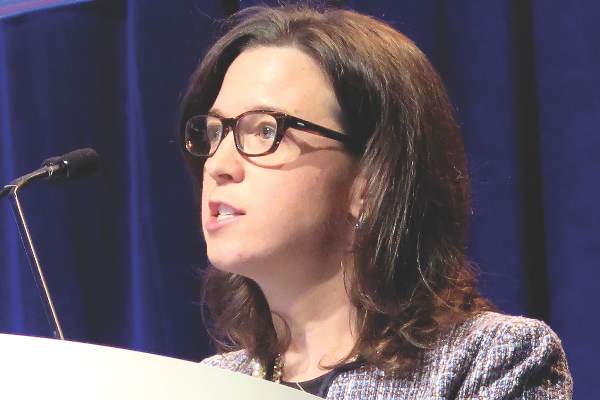User login
SAN FRANCISCO – The immune checkpoint inhibitor atezolizumab is highly active and well tolerated in patients with platinum-treated advanced urothelial carcinoma and may in fact change management of this disease, according to a phase II trial reported at the 2016 Genitourinary Cancers Symposium.
The trial, IMvigor 210, was conducted in Europe, Canada, and the United States among patients who had locally advanced or metastatic urothelial carcinoma. Lead investigator Dr. Jean H. Hoffman-Censits reported findings for the trial’s second cohort, which enrolled 310 patients who had had progression on or after platinum-based chemotherapy, with no limit on the number of lines of prior therapy.
At 3-week intervals, the patients received atezolizumab, an investigational antibody that targets programmed death–ligand 1 (PD-L1), preventing it from binding to the programmed death–1 (PD-1) receptor on T cells and thereby enhancing their activity, Dr. Hoffman-Censits reported at the symposium, sponsored by the American Society of Clinical Oncology, ASTRO, and the Society of Urologic Oncology.
The overall response rate was 15% in the entire cohort and 26% in the subset of patients whose immune cells had high expression of PD-L1 by immunohistochemistry. Values in all prespecified groups exceeded the bar of 10% that the investigators had selected on the basis of second-line trials, even though many patients in IMvigor were being treated in later lines.
Atezolizumab was well tolerated. Overall, 16% of patients experienced grade 3 or 4 treatment-related adverse events; only 4% of patients stopping treatment because of such events, reported Dr. Hoffman-Censits of the Kimmel Cancer Center, Thomas Jefferson University Hospital in Philadelphia.
“Given the current landscape of chemotherapy options for our patients with urothelial cancer progressing following platinum chemotherapy, this primary analysis of IMvigor 210 demonstrates that atezolizumab has the potential to change the standard of care for metastatic urothelial cancers,” Dr. Hoffman-Censits maintained. “Higher PD-L1 [immune cell] status was associated with higher response rates, but low PD-L1 status or poor prognostic factors did not preclude responses,” she noted.
A pair of ongoing randomized phase III trials are testing atezolizumab in metastatic urothelial carcinoma and as adjuvant therapy in muscle-invasive bladder cancer. Also, there is now an expanded-access trial for patients with platinum-treated metastatic urothelial carcinoma.
“We look forward to the results of these trials, which will continue to define the role of atezolizumab in the treatment of patients with urothelial cancers,” she concluded.
Invited discussant Dr. William Y. Kim of the Lineberger Comprehensive Cancer Center, University of North Carolina, in Chapel Hill, noted that patients given immunotherapies such as atezolizumab can experience both pseudoprogression and delayed response, which may be misclassified with the RECIST criteria used in the trial. However, it is not yet clear whether immune-related response criteria will be useful in urothelial cancers.
“In IMvigor 210, we anxiously await the results of cohort one,” he said, referring to a separate group of patients who were not eligible for platinum chemotherapy. “Follow-up regarding the durability of these responses will be needed as well.”
Atezolizumab’s mechanism of action is attractive in urothelial cancer, Dr. Hoffman-Censits noted when introducing the trial.
“By inhibiting binding of PD-L1 to PD-1 and B7.1, atezolizumab can enhance T-cell priming and reinvigorate suppressed immune cells,” she explained. “However, by leaving the interaction between PD-L2 and PD-1 intact, atezolizumab can preserve peripheral immune homeostasis. Urothelial cancers have a high mutation burden, which potentially can lead to neoantigen formation, and those [new antigens] could be recognized by the immune system.”
Three-fourths of the 310 patients studied had bladder cancer. A total of 41% had previously received two or more therapies for metastatic disease.
Immunohistochemistry showed high PD-L1 staining of immune cells (5% or more positive) in 32% of patients, intermediate staining (between 1% and 5% positive) in 35%, and low staining (less than 1% positive) in 33%.
The overall response rate according to RECIST criteria with central review was 15% in the entire cohort, 18% in patients with intermediate or high PD-L1 staining, and 26% in patients with high PD-L1 staining.
“Surprisingly, complete responses were seen in this group,” Dr. Hoffman-Censits commented. “This is a phenomenon that is incredibly rare in second-line and beyond clinical trials.”
The rate of complete response was 5% in the entire cohort, 6% in patients with intermediate or high PD-L1 staining, and 11% in patients with high PD-L1 staining. Of note, some complete responses were seen even in those with low staining.
With a median follow-up of 11.7 months, the median duration of response had not been reached; fully 84% of patients who initially had a response still had an ongoing response at the time of data cutoff. Stable disease was likewise durable.
When patients were stratified by prognostic factors, the overall response rate was highest, at 23%, among those with lymph nodes as the only site of metastases.
Median progression-free survival was 2.1 months in the entire cohort and also regardless of PD-L1 staining. Median overall survival was 7.9 months in the entire cohort; it was longer for patients with high staining (11.4 months) than for peers with intermediate or low staining (6.7 months).
The 12-month overall survival rate was 36% for the entire cohort, 30% for patients with low or intermediate staining, and 48% for patients with high staining.
“Considering 12-month overall survival estimates for second-line chemo are approximately 20%, these data are truly exciting,” Dr. Hoffman-Censits said.
Analysis of adverse events showed that atezolizumab had a favorable safety profile. In particular, there were no immune-mediated adverse events deemed to be related to treatment.
SAN FRANCISCO – The immune checkpoint inhibitor atezolizumab is highly active and well tolerated in patients with platinum-treated advanced urothelial carcinoma and may in fact change management of this disease, according to a phase II trial reported at the 2016 Genitourinary Cancers Symposium.
The trial, IMvigor 210, was conducted in Europe, Canada, and the United States among patients who had locally advanced or metastatic urothelial carcinoma. Lead investigator Dr. Jean H. Hoffman-Censits reported findings for the trial’s second cohort, which enrolled 310 patients who had had progression on or after platinum-based chemotherapy, with no limit on the number of lines of prior therapy.
At 3-week intervals, the patients received atezolizumab, an investigational antibody that targets programmed death–ligand 1 (PD-L1), preventing it from binding to the programmed death–1 (PD-1) receptor on T cells and thereby enhancing their activity, Dr. Hoffman-Censits reported at the symposium, sponsored by the American Society of Clinical Oncology, ASTRO, and the Society of Urologic Oncology.
The overall response rate was 15% in the entire cohort and 26% in the subset of patients whose immune cells had high expression of PD-L1 by immunohistochemistry. Values in all prespecified groups exceeded the bar of 10% that the investigators had selected on the basis of second-line trials, even though many patients in IMvigor were being treated in later lines.
Atezolizumab was well tolerated. Overall, 16% of patients experienced grade 3 or 4 treatment-related adverse events; only 4% of patients stopping treatment because of such events, reported Dr. Hoffman-Censits of the Kimmel Cancer Center, Thomas Jefferson University Hospital in Philadelphia.
“Given the current landscape of chemotherapy options for our patients with urothelial cancer progressing following platinum chemotherapy, this primary analysis of IMvigor 210 demonstrates that atezolizumab has the potential to change the standard of care for metastatic urothelial cancers,” Dr. Hoffman-Censits maintained. “Higher PD-L1 [immune cell] status was associated with higher response rates, but low PD-L1 status or poor prognostic factors did not preclude responses,” she noted.
A pair of ongoing randomized phase III trials are testing atezolizumab in metastatic urothelial carcinoma and as adjuvant therapy in muscle-invasive bladder cancer. Also, there is now an expanded-access trial for patients with platinum-treated metastatic urothelial carcinoma.
“We look forward to the results of these trials, which will continue to define the role of atezolizumab in the treatment of patients with urothelial cancers,” she concluded.
Invited discussant Dr. William Y. Kim of the Lineberger Comprehensive Cancer Center, University of North Carolina, in Chapel Hill, noted that patients given immunotherapies such as atezolizumab can experience both pseudoprogression and delayed response, which may be misclassified with the RECIST criteria used in the trial. However, it is not yet clear whether immune-related response criteria will be useful in urothelial cancers.
“In IMvigor 210, we anxiously await the results of cohort one,” he said, referring to a separate group of patients who were not eligible for platinum chemotherapy. “Follow-up regarding the durability of these responses will be needed as well.”
Atezolizumab’s mechanism of action is attractive in urothelial cancer, Dr. Hoffman-Censits noted when introducing the trial.
“By inhibiting binding of PD-L1 to PD-1 and B7.1, atezolizumab can enhance T-cell priming and reinvigorate suppressed immune cells,” she explained. “However, by leaving the interaction between PD-L2 and PD-1 intact, atezolizumab can preserve peripheral immune homeostasis. Urothelial cancers have a high mutation burden, which potentially can lead to neoantigen formation, and those [new antigens] could be recognized by the immune system.”
Three-fourths of the 310 patients studied had bladder cancer. A total of 41% had previously received two or more therapies for metastatic disease.
Immunohistochemistry showed high PD-L1 staining of immune cells (5% or more positive) in 32% of patients, intermediate staining (between 1% and 5% positive) in 35%, and low staining (less than 1% positive) in 33%.
The overall response rate according to RECIST criteria with central review was 15% in the entire cohort, 18% in patients with intermediate or high PD-L1 staining, and 26% in patients with high PD-L1 staining.
“Surprisingly, complete responses were seen in this group,” Dr. Hoffman-Censits commented. “This is a phenomenon that is incredibly rare in second-line and beyond clinical trials.”
The rate of complete response was 5% in the entire cohort, 6% in patients with intermediate or high PD-L1 staining, and 11% in patients with high PD-L1 staining. Of note, some complete responses were seen even in those with low staining.
With a median follow-up of 11.7 months, the median duration of response had not been reached; fully 84% of patients who initially had a response still had an ongoing response at the time of data cutoff. Stable disease was likewise durable.
When patients were stratified by prognostic factors, the overall response rate was highest, at 23%, among those with lymph nodes as the only site of metastases.
Median progression-free survival was 2.1 months in the entire cohort and also regardless of PD-L1 staining. Median overall survival was 7.9 months in the entire cohort; it was longer for patients with high staining (11.4 months) than for peers with intermediate or low staining (6.7 months).
The 12-month overall survival rate was 36% for the entire cohort, 30% for patients with low or intermediate staining, and 48% for patients with high staining.
“Considering 12-month overall survival estimates for second-line chemo are approximately 20%, these data are truly exciting,” Dr. Hoffman-Censits said.
Analysis of adverse events showed that atezolizumab had a favorable safety profile. In particular, there were no immune-mediated adverse events deemed to be related to treatment.
SAN FRANCISCO – The immune checkpoint inhibitor atezolizumab is highly active and well tolerated in patients with platinum-treated advanced urothelial carcinoma and may in fact change management of this disease, according to a phase II trial reported at the 2016 Genitourinary Cancers Symposium.
The trial, IMvigor 210, was conducted in Europe, Canada, and the United States among patients who had locally advanced or metastatic urothelial carcinoma. Lead investigator Dr. Jean H. Hoffman-Censits reported findings for the trial’s second cohort, which enrolled 310 patients who had had progression on or after platinum-based chemotherapy, with no limit on the number of lines of prior therapy.
At 3-week intervals, the patients received atezolizumab, an investigational antibody that targets programmed death–ligand 1 (PD-L1), preventing it from binding to the programmed death–1 (PD-1) receptor on T cells and thereby enhancing their activity, Dr. Hoffman-Censits reported at the symposium, sponsored by the American Society of Clinical Oncology, ASTRO, and the Society of Urologic Oncology.
The overall response rate was 15% in the entire cohort and 26% in the subset of patients whose immune cells had high expression of PD-L1 by immunohistochemistry. Values in all prespecified groups exceeded the bar of 10% that the investigators had selected on the basis of second-line trials, even though many patients in IMvigor were being treated in later lines.
Atezolizumab was well tolerated. Overall, 16% of patients experienced grade 3 or 4 treatment-related adverse events; only 4% of patients stopping treatment because of such events, reported Dr. Hoffman-Censits of the Kimmel Cancer Center, Thomas Jefferson University Hospital in Philadelphia.
“Given the current landscape of chemotherapy options for our patients with urothelial cancer progressing following platinum chemotherapy, this primary analysis of IMvigor 210 demonstrates that atezolizumab has the potential to change the standard of care for metastatic urothelial cancers,” Dr. Hoffman-Censits maintained. “Higher PD-L1 [immune cell] status was associated with higher response rates, but low PD-L1 status or poor prognostic factors did not preclude responses,” she noted.
A pair of ongoing randomized phase III trials are testing atezolizumab in metastatic urothelial carcinoma and as adjuvant therapy in muscle-invasive bladder cancer. Also, there is now an expanded-access trial for patients with platinum-treated metastatic urothelial carcinoma.
“We look forward to the results of these trials, which will continue to define the role of atezolizumab in the treatment of patients with urothelial cancers,” she concluded.
Invited discussant Dr. William Y. Kim of the Lineberger Comprehensive Cancer Center, University of North Carolina, in Chapel Hill, noted that patients given immunotherapies such as atezolizumab can experience both pseudoprogression and delayed response, which may be misclassified with the RECIST criteria used in the trial. However, it is not yet clear whether immune-related response criteria will be useful in urothelial cancers.
“In IMvigor 210, we anxiously await the results of cohort one,” he said, referring to a separate group of patients who were not eligible for platinum chemotherapy. “Follow-up regarding the durability of these responses will be needed as well.”
Atezolizumab’s mechanism of action is attractive in urothelial cancer, Dr. Hoffman-Censits noted when introducing the trial.
“By inhibiting binding of PD-L1 to PD-1 and B7.1, atezolizumab can enhance T-cell priming and reinvigorate suppressed immune cells,” she explained. “However, by leaving the interaction between PD-L2 and PD-1 intact, atezolizumab can preserve peripheral immune homeostasis. Urothelial cancers have a high mutation burden, which potentially can lead to neoantigen formation, and those [new antigens] could be recognized by the immune system.”
Three-fourths of the 310 patients studied had bladder cancer. A total of 41% had previously received two or more therapies for metastatic disease.
Immunohistochemistry showed high PD-L1 staining of immune cells (5% or more positive) in 32% of patients, intermediate staining (between 1% and 5% positive) in 35%, and low staining (less than 1% positive) in 33%.
The overall response rate according to RECIST criteria with central review was 15% in the entire cohort, 18% in patients with intermediate or high PD-L1 staining, and 26% in patients with high PD-L1 staining.
“Surprisingly, complete responses were seen in this group,” Dr. Hoffman-Censits commented. “This is a phenomenon that is incredibly rare in second-line and beyond clinical trials.”
The rate of complete response was 5% in the entire cohort, 6% in patients with intermediate or high PD-L1 staining, and 11% in patients with high PD-L1 staining. Of note, some complete responses were seen even in those with low staining.
With a median follow-up of 11.7 months, the median duration of response had not been reached; fully 84% of patients who initially had a response still had an ongoing response at the time of data cutoff. Stable disease was likewise durable.
When patients were stratified by prognostic factors, the overall response rate was highest, at 23%, among those with lymph nodes as the only site of metastases.
Median progression-free survival was 2.1 months in the entire cohort and also regardless of PD-L1 staining. Median overall survival was 7.9 months in the entire cohort; it was longer for patients with high staining (11.4 months) than for peers with intermediate or low staining (6.7 months).
The 12-month overall survival rate was 36% for the entire cohort, 30% for patients with low or intermediate staining, and 48% for patients with high staining.
“Considering 12-month overall survival estimates for second-line chemo are approximately 20%, these data are truly exciting,” Dr. Hoffman-Censits said.
Analysis of adverse events showed that atezolizumab had a favorable safety profile. In particular, there were no immune-mediated adverse events deemed to be related to treatment.
AT THE GENITOURINARY CANCERS SYMPOSIUM
Key clinical point: Atezolizumab is active in advanced urothelial cancer, especially in patients whose immune cells have higher expression of PD-L1.
Major finding: The overall response rate was 15% in the entire cohort and 26% in the subset with high PD-L1 staining. The rate of grade 3 or 4 treatment-related adverse events was 16%.
Data source: An analysis of 310 patients with platinum-treated locally advanced or metastatic urothelial carcinoma on a phase II trial (IMvigor 210 trial).
Disclosures: Dr. Hoffman-Censits disclosed that she receives honoraria from and has a consulting or advisory role with Roche/Genentech, and receives research funding from Sanofi. The study was funded by F. Hoffman-LaRoche. Dr. Kim disclosed that he owns stock in Agios, Bristol-Myers Squibb, Johnson & Johnson, Medivation, and Merck, and that he has a patent for the BASE47 bladder cancer subtype classifier.


